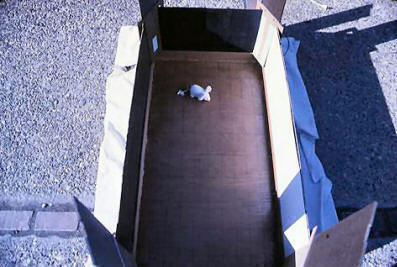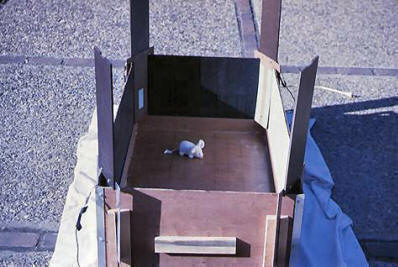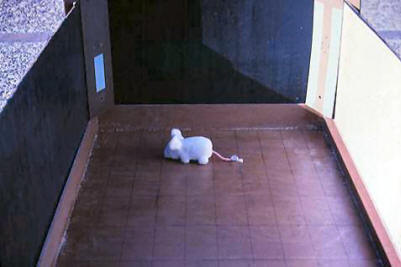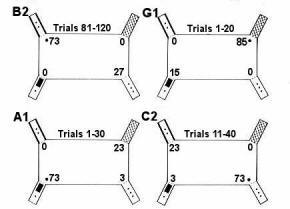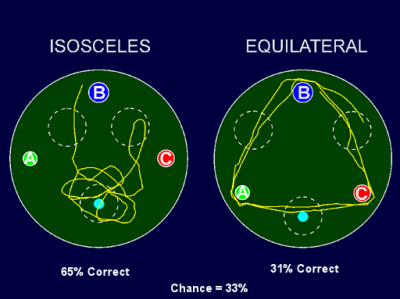Geometry, features, and orientation in vertebrate
animals: A pictorial review
Ken Cheng and Nora S. Newcombe
Macquarie University & Temple University
Basic Phenomena: Rats
|
|
| Figure A-1:
The
idea of the use of the geometry of surfaces
started with the doctoral work of Ken Cheng.
Here are four pictures of the rectangular arena
used to test the animals, male white rats.
|
|
|
| Figure A-2:
The
arena measured 120 cm by 60 cm. The photos were
taken outside, not in lab conditions. Not easy
to notice in the photos are two additional kinds
of cues: different textures on the corner panels
and smells emanating from two of the corners.
|
|
|
| Figure A-3:
One end
of the apparatus
|
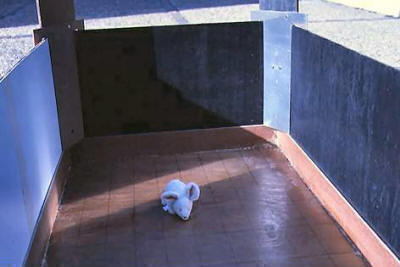 |
| Figure A-4: The other end of the apparatus |
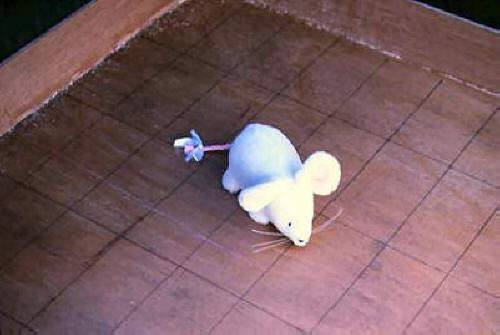 |
| Figure A-5:
In
the experiments, the bottom of the arena was
filled with saw dust (wood chips used for rat
bedding). A grid was drawn on the bottom for the
purposes of scoring where the rats dug.
|
|
|
| Figure A-6:
These
photos, of the two ends of the rectangular
arena, were taken in the lab, from the floor of
the box. They represent roughly what a rat saw
in the tasks.
|
 |
| Figure A-7: Schematic Illustration of the basic task. |
The task was a working memory find-the-treasure-again task. A box (12 X 6 cm) was put on the bottom of the arena at a randomly chosen location. A. In the exposure phase, the box was exposed, revealing 7 pellets of sweet cereal. The rat got to eat 3 pellets, and then was removed outside the room. C. The arena (actually an identical looking replica) was rotated at random, the remaining food was buried under saw dust, and the rat was returned to the arena 90 s later to dig up the remaining food.
 |
| Figure A-8: Rotational Error |
The rotational error is crucial to understanding this entire corpus of work. A. A plan view of the task situation, with the location of the food indicated by the filled dot. The open dot shows the rotational error, located at 180 degrees rotation through the center from the correct location. B. A record or representation of the geometric properties, with the food location indicated by the dot. This representation contains only the broad shape of the space, called the geometric properties. Missing are smells, textures, colors of walls, the information shown in C. Using a record such as B. can lead to rotational errors. This happens when the top wall of B. is matched to the bottom wall of of A., with the box in B. rotated 180 degrees. Using a record of the nongeometric information, called featural information, shown in C. results in an unambiguous match. Systematic rotational errors thus indicate a record such as that shown in B. We will argue later that far less than the entire geometric shape is represented by rats.
 |
| Figure A-9: Geometry and rotational error |
It is important to note what geometric properties are needed to solve the problem up to rotational ambiguity (Cheng & Gallistel, 1984). The animal must encode both metric properties (lengths of walls) and distinguish left/right (whether the long wall is to the right or left of the short wall at the target). This property is known as sense. Ignoring either lengths (bottom left) or sense (bottom right) renders all four corners equivalent and confusable.
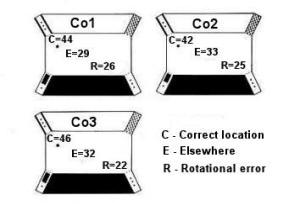 |
| Figure A-10: Results from Cheng (1986) |
Results of individual rats in the working memory task in Cheng (1986). C stands for correct choices, R stands for rotational errors, and E stands for everything else (other nonsystematic wrong choices or no digging at all). Each rat made a significant number of rotational errors. The advantage of correct choices over rotational errors (not statistically significant in any rat) is attributed to the fact that the rats were not disoriented during the delay. Margules and Gallistel (1988) repeated this experiment with disorientation during the delay period. The rats then make approximately equal numbers of correct choices and rotational errors.
|
|
| Figure A-11: Cheng (1986) results averaged over the three rats. |
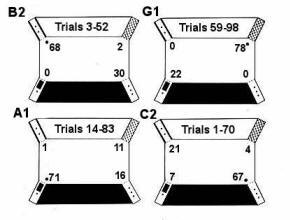 |
| Figure A-12:
Results from reference memory task
|
In a reference memory task (Cheng, 1986, Experiment 2), the food stayed in one of the corners on every trial. The rats then learned to choose the correct corner over the rotational error (diagonal opposite). The rats as a group, however, still made systematic rotational errors. This pattern (correct choice over rotational error, but systematic rotational errors still) is also found in young children and rhesus monkeys.
|
|
| Figure A-13:
Cheng’s rats chose the correct corner
over the rotational error even when the
white wall was made black, making the
colors of walls nondiagnostic for
locating the food. Again, they still
made systematic rotational errors.
|
|
Chance = 33% |
| Figure A-14: Benhamou and Poucet's swimming pool task (Thanks to Simon Benhamou for providing this picture) |
Benhamou and Poucet (1998) introduced two differences in the reference memory paradigm. 1) Their task was aversive rather than appetitive. Others have noted differences in performance between appetitive and aversive tasks. Golob and Taube (2002) found that in a rectangular swimming pool, rats did not make systematic rotational errors. In a dry, appetitive task in the same arena, rotational errors were prevalent. 2) The geometry was defined by an array of objects, not by surfaces. The pool was round and surrounded by a ring of curtains, rendering its geometry useless for the task.
The blue dot at the bottoms of the panels shows the target position. The landmarks were different from one another perceptually. In the left panel, the configuration of landmarks specified the target unambiguously, and the rats learned to searched preferentially around the target. In the right panel, the configuration of landmarks left a threefold ambiguity as to target position. Individual perceptual identities of the landmarks needed to be used to resolve the ambiguity. The rats did not learn to resolve this ambiguity in 75 trials.
This task is much harder than a standard pool task with lots of room cues, which supply both geometric and featural cues (Poucet, Lenck-Santini, & Save, 2003).
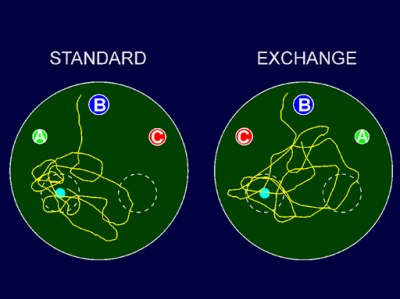 |
| Figure A-15: Landmarks vs. Configuration (Thanks to Simon Benhamou for providing this picture) |
This manipulation shows that it is the configuration of landmarks, rather than the individual identities of landmarks, that was important for the rats. The blue dot at the bottoms of the panels again shows the target. When the landmarks swapped position (right panel),the configuration of landmarks and the individual identity of the nearest landmark dictated different responses. Rats mostly ‘went with’ the configuration, although their performance was slightly (and significantly) worse than under standard testing conditions (Benhamou & Poucet, 1998).
|
